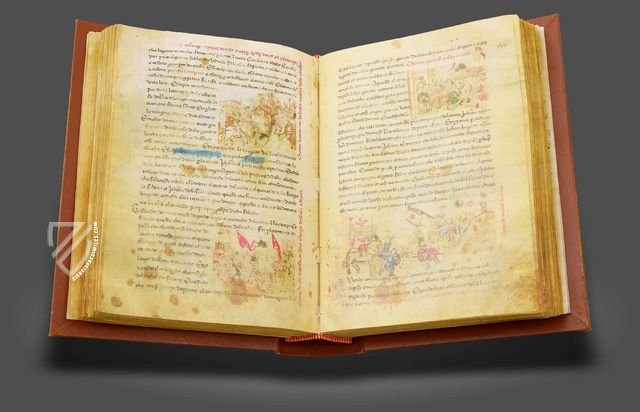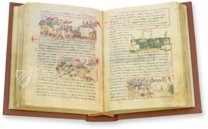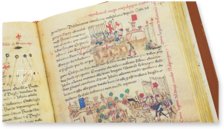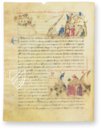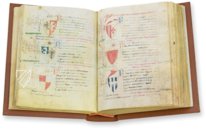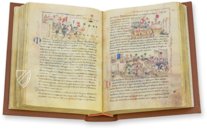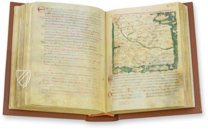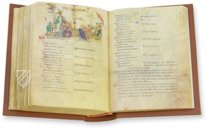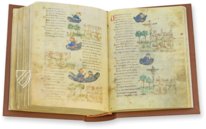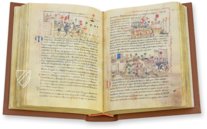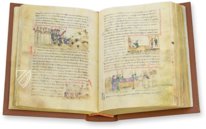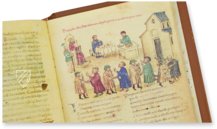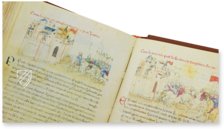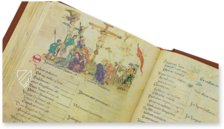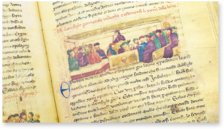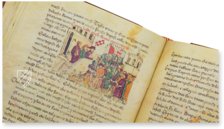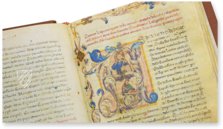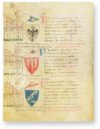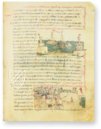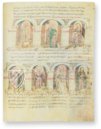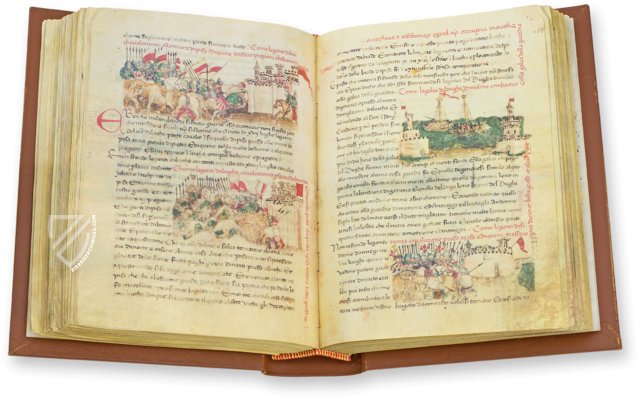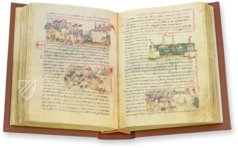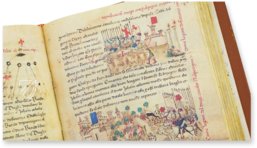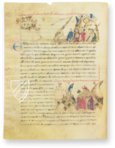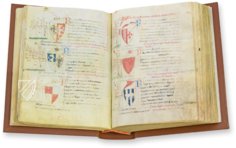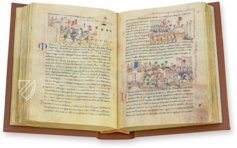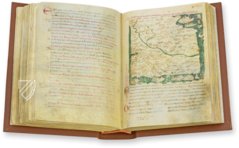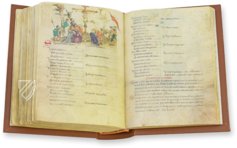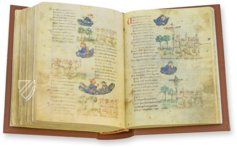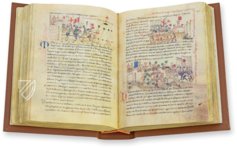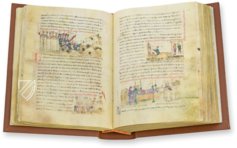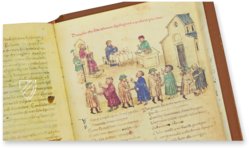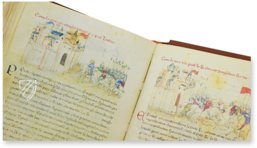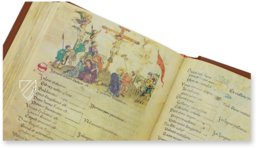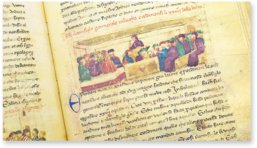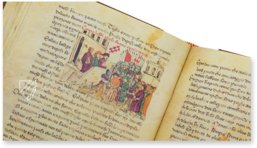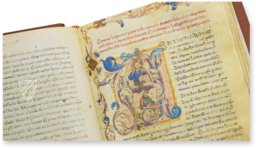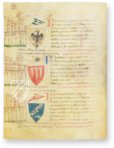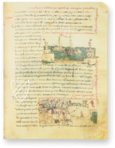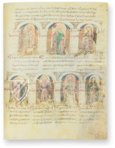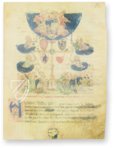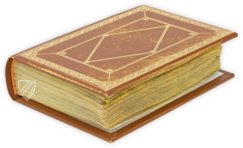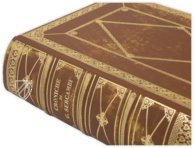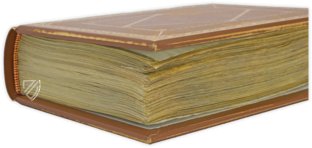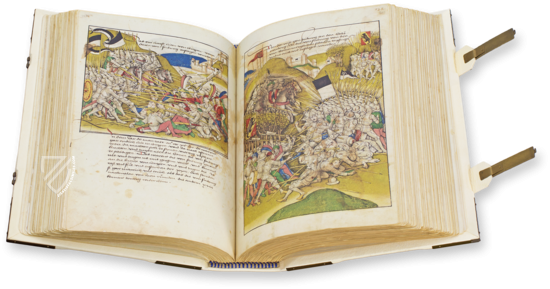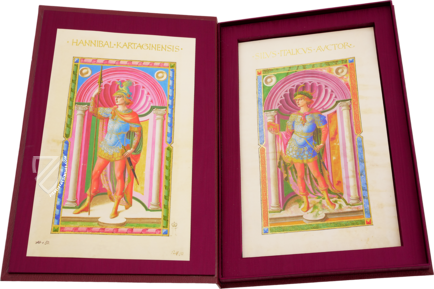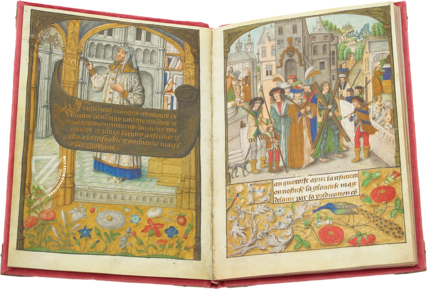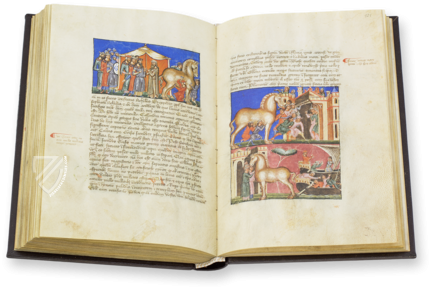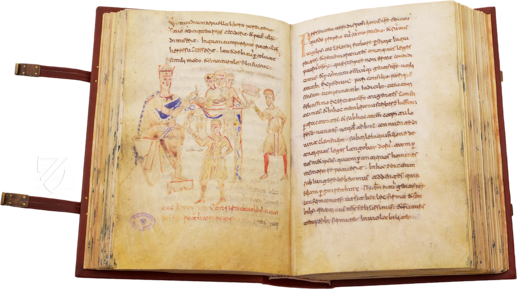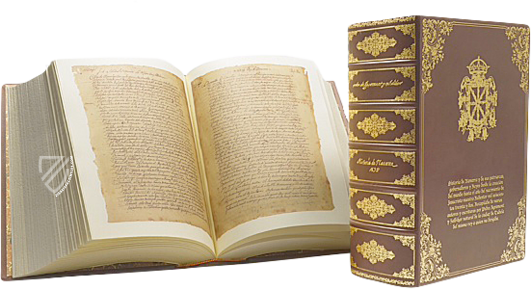Chronicles of Lucca by Giovanni Sercambi
(1,000€ - 3,000€)
Up until the beginning of the 15th century, the Italian city of Lucca, like so many other cities in medieval Europe, was afflicted by political corruption, wars and murders as well as the Black Death, the plague. However, with the accession of Paolo Guinigi (ca. 1372-1432) on November 21, 1400, the tide slowly turned for the depleted citizenry - a thirty-year period of relative peace and prosperity began. In the Chronicles of Lucca, Giovanni Sercambi (1348-1424), writer and supporter of the new governor of the city, narrates the significant historical events and developments in Lucca in the period from 1164 to 1423. The vivid descriptions of the fascinating text are wonderfully illuminated by 651 smaller and larger miniatures, some of which are spread across the page and some of which are integrated into the writing area, which is an artful extension of the historical relevance of the work.
Chronicles of Lucca by Giovanni Sercambi
A chronic is a historical work of prose, which represents historic events organized in chronological order. While some of the chronicles of the Middle Ages are merely a listing of historically-important dates, others contain detailed accounts of the events of individual years and were furnished with splendid miniatures. One of the most beautiful and exciting city chronicles of the 14th and 15th centuries was composed by the Italian writer Giovanni Sercambi (1348-1424). He wrote a historical reference work about his beloved home city of Lucca. He recorded the special topographic and architectural features of the city, as well as important historical events and demonstrated the everyday life of the citizens of Lucca in the High Middle Ages in over 651 richly-detailed illustrations.
A Famous Scribe
Giovanni Sercambi one of the most important and highly-respected citizens of the Italian city of Lucca. The highly-educated Sercambi worked here as an apothecary and was simultaneously one of the most famous and influential authors in the city. Sercambi was a supporter of the ruling Guinigi family and served as a soldier and public functionary in their name. His Chronica delle cose di Lucca relates the history of his city from 1164 to 1423 and made him famous beyond the borders of Lucca and throughout Italy. Alongside his chronicle, he is known today above all for his works Novelle and Monito, in which he concerned himself with biological facts about the ancestry and provenance of the citizens of Lucca. With his comprehensive knowledge of the natural sciences and authorial ability, Sercambi was an important forerunner of the Renaissance.
At the Behest of the Princely Family
At the beginning of the 15th century, Lucca was tormented by political corruption, murders, and an outbreak of plague. In this same period, the House of Guinigi emerged as the wealthiest and unquestionably the most influential family in the city. As a result of acts of revenge and assignations within the family, only the youngest son of the aristocratic house, Paolo (ca. 1372 - 1432), survived the year 1400. On November 21st, 1400, he was named the noble governor of Lucca, which he largely owed to the wise council of his friend and public official Giovanni Sercambi. His ascent to office marked the beginning of a 30 year period of relative peace and truce in the history of Lucca. One confronted conspiracies and moments of tension with wisdom, deliberation, and without vengeance, and the city also flourished economically. Sercambi’s chronicle allowed Paolo Guinigi to record the fateful events of his city for the sake of posterity.
Codicology
- Alternative Titles
- La Crónica de Lucca
La Cronica de Lucca de Giovanni Sercambi
Le croniche di Luccha
Chronik von Lucca von Giovanni Sercambi - Size / Format
- 726 pages / 27.7 × 20.0 cm
- Origin
- Italy
- Date
- Ca. 1368–1424
- Epochs
- Style
- Language
- Script
- Littera bastarda
- Illustrations
- 651 miniatures
- Artist / School
- Giovanni Sercambi (1348–1424) (author)
- Previous Owners
- Paolo Guinigi
Chronicles of Lucca by Giovanni Sercambi
Florentine Troops on the March
Identifiable by their distinctive red fleur-de-lis, Florentine cavalry are shown riding on horseback as foot soldiers drive a herd of cattle past a walled city. Animals were an important part of any medieval army and were part of the baggage train that followed it. The Florentine soldiers are equipped with chainmail and open faced steel helmets; their lances are like a forest. One man among them has a purple hat and stripped coat, likely the condottiero or “captain”, perhaps a legate.
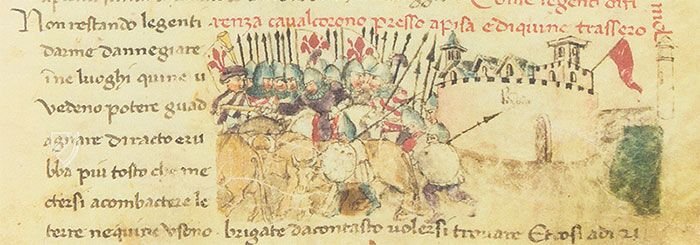
Chronicles of Lucca by Giovanni Sercambi
Urban VI Besieged by Charles III in the Castle of Nocera
During the War of the Eight Saints, a conflict between the Papacy and an alliance of Italian states and communes, Pope Urban VI was forced to flee Rome, finding refuge in the castle of the city of Nocera Inferiore. There, he was besieged by his cousin and enemy, King Charles III of Naples. This war was part of the Western Schism, which split the Catholic Church between pope and anti-pope.
The upper miniature on the page depicts the camp and army of Charles III, mostly consisting of mercenary troops under the command of the famous English condottiero Sir John Hawkwood. A trebuchet is depicted having just launched a stone, shown flying through the air. In the lower miniature, Urban is freed by two Neapolitan barons after 6 months of siege.
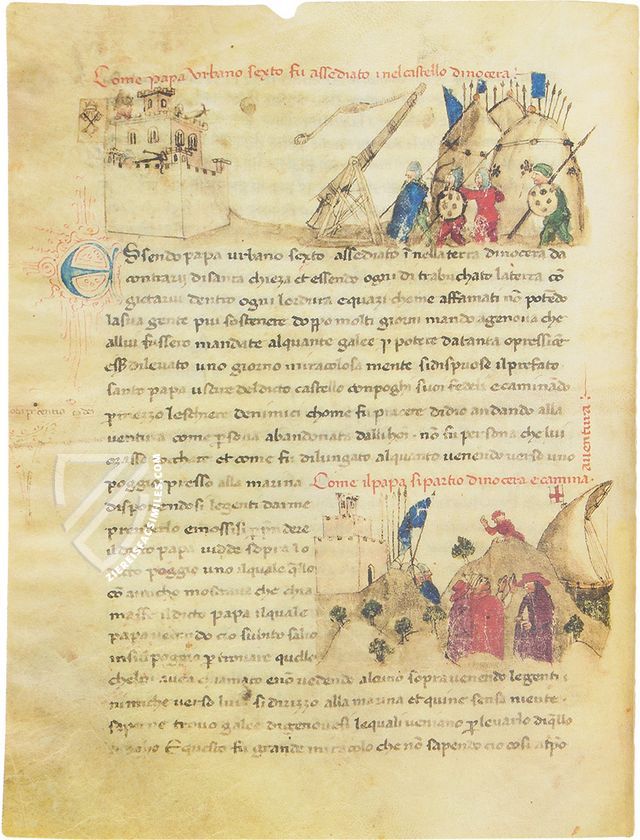
#1 La Crónica de Lucca
Language: English, Spanish
(1,000€ - 3,000€)
- Treatises / Secular Books
- Apocalypses / Beatus
- Astronomy / Astrology
- Bestiaries
- Bibles / Gospels
- Chronicles / History / Law
- Geography / Maps
- Saints' Lives
- Islam / Oriental
- Judaism / Hebrew
- Single Leaf Collections
- Leonardo da Vinci
- Literature / Poetry
- Liturgical Manuscripts
- Medicine / Botany / Alchemy
- Music
- Mythology / Prophecies
- Psalters
- Other Religious Books
- Games / Hunting
- Private Devotion Books
- Other Genres
- Afghanistan
- Armenia
- Austria
- Belgium
- Belize
- Bosnia and Herzegovina
- China
- Colombia
- Costa Rica
- Croatia
- Cyprus
- Czech Republic
- Denmark
- Egypt
- El Salvador
- Ethiopia
- France
- Germany
- Greece
- Guatemala
- Honduras
- Hungary
- India
- Iran
- Iraq
- Israel
- Italy
- Japan
- Jordan
- Kazakhstan
- Kyrgyzstan
- Lebanon
- Liechtenstein
- Luxembourg
- Mexico
- Morocco
- Netherlands
- Palestine
- Panama
- Peru
- Poland
- Portugal
- Romania
- Russia
- Serbia
- Spain
- Sri Lanka
- Sweden
- Switzerland
- Syria
- Tajikistan
- Turkey
- Turkmenistan
- Ukraine
- United Kingdom
- United States
- Uzbekistan
- Vatican City
- A. Oosthoek, van Holkema & Warendorf
- Aboca Museum
- Ajuntament de Valencia
- Akademie Verlag
- Akademische Druck- u. Verlagsanstalt (ADEVA)
- Aldo Ausilio Editore - Bottega d’Erasmo
- Alecto Historical Editions
- Alkuin Verlag
- Almqvist & Wiksell
- Amilcare Pizzi
- Andreas & Andreas Verlagsbuchhandlung
- Archa 90
- Archiv Verlag
- Archivi Edizioni
- Arnold Verlag
- ARS
- Ars Magna
- ArtCodex
- AyN Ediciones
- Azimuth Editions
- Badenia Verlag
- Bärenreiter-Verlag
- Belser Verlag
- Belser Verlag / WK Wertkontor
- Benziger Verlag
- Bernardinum Wydawnictwo
- BiblioGemma
- Biblioteca Apostolica Vaticana (Vaticanstadt, Vaticanstadt)
- Bibliotheca Palatina Faksimile Verlag
- Bibliotheca Rara
- Boydell & Brewer
- Bramante Edizioni
- Bredius Genootschap
- Brepols Publishers
- British Library
- C. Weckesser
- Caixa Catalunya
- Canesi
- CAPSA, Ars Scriptoria
- Caratzas Brothers, Publishers
- Carus Verlag
- Casamassima Libri
- Centrum Cartographie Verlag GmbH
- Chavane Verlag
- Christian Brandstätter Verlag
- Circulo Cientifico
- Club Bibliófilo Versol
- Club du Livre
- CM Editores
- Collegium Graphicum
- Collezione Apocrifa Da Vinci
- Comissão Nacional para as Comemorações dos Descobrimentos Portugueses
- Coron Verlag
- Corvina
- CTHS
- D. S. Brewer
- Damon
- De Agostini/UTET
- De Nederlandsche Boekhandel
- De Schutter
- Deuschle & Stemmle
- Deutscher Verlag für Kunstwissenschaft
- DIAMM
- Droz
- E. Schreiber Graphische Kunstanstalten
- Ediciones Boreal
- Ediciones Grial
- Ediclube
- Edições Inapa
- Edilan
- Editalia
- Edition Deuschle
- Edition Georg Popp
- Edition Leipzig
- Edition Libri Illustri
- Editiones Reales Sitios S. L.
- Éditions de l'Oiseau Lyre
- Editions Medicina Rara
- Editorial Casariego
- Editorial Mintzoa
- Editrice Antenore
- Editrice Velar
- Edizioni Edison
- Egeria, S.L.
- Eikon Editores
- Electa
- Emery Walker Limited
- Enciclopèdia Catalana
- Eos-Verlag
- Ephesus Publishing
- Ernst Battenberg
- Eugrammia Press
- Extraordinary Editions
- Fackelverlag
- Facsimila Art & Edition
- Facsimile Editions Ltd.
- Facsimilia Art & Edition Ebert KG
- Faksimile Verlag
- Feuermann Verlag
- Folger Shakespeare Library
- Franco Cosimo Panini Editore
- Friedrich Wittig Verlag
- Fundación Hullera Vasco-Leonesa
- G. Braziller
- Gabriele Mazzotta Editore
- Gebr. Mann Verlag
- Gesellschaft für graphische Industrie
- Getty Research Institute
- Giovanni Domenico de Rossi
- Giunti Editore
- Graffiti
- Grafica European Center of Fine Arts
- Guido Pressler
- Guillermo Blazquez
- Gustav Kiepenheuer
- H. N. Abrams
- Harrassowitz
- Harvard University Press
- Helikon
- Hendrickson Publishers
- Henning Oppermann
- Herder Verlag
- Hes & De Graaf Publishers
- Hoepli
- Holbein-Verlag
- Houghton Library
- Hugo Schmidt Verlag
- Idion Verlag
- Il Bulino, edizioni d'arte
- ILte
- Imago
- Insel Verlag
- Insel-Verlag Anton Kippenberger
- Instituto de Estudios Altoaragoneses
- Instituto Nacional de Antropología e Historia
- Introligatornia Budnik Jerzy
- Istituto dell'Enciclopedia Italiana - Treccani
- Istituto Ellenico di Studi Bizantini e Postbizantini
- Istituto Geografico De Agostini
- Istituto Poligrafico e Zecca dello Stato
- Italarte Art Establishments
- Jan Thorbecke Verlag
- Johnson Reprint Corporation
- Josef Stocker
- Josef Stocker-Schmid
- Jugoslavija
- Karl W. Hiersemann
- Kasper Straube
- Kaydeda Ediciones
- Kindler Verlag / Coron Verlag
- Kodansha International Ltd.
- Konrad Kölbl Verlag
- Kurt Wolff Verlag
- La Liberia dello Stato
- La Linea Editrice
- La Meta Editore
- Lambert Schneider
- Landeskreditbank Baden-Württemberg
- Leo S. Olschki
- Les Incunables
- Liber Artis
- Library of Congress
- Libreria Musicale Italiana
- Lichtdruck
- Lito Immagine Editore
- Lumen Artis
- Lund Humphries
- M. Moleiro Editor
- Maison des Sciences de l'homme et de la société de Poitiers
- Manuscriptum
- Martinus Nijhoff
- Maruzen-Yushodo Co. Ltd.
- MASA
- Massada Publishers
- McGraw-Hill
- Metropolitan Museum of Art
- Militos
- Millennium Liber
- Müller & Schindler
- Nahar - Stavit
- Nahar and Steimatzky
- National Library of Wales
- Neri Pozza
- Nova Charta
- Oceanum Verlag
- Odeon
- Orbis Mediaevalis
- Orbis Pictus
- Österreichische Staatsdruckerei
- Oxford University Press
- Pageant Books
- Parzellers Buchverlag
- Patrimonio Ediciones
- Pattloch Verlag
- PIAF
- Pieper Verlag
- Plon-Nourrit et cie
- Poligrafiche Bolis
- Presses Universitaires de Strasbourg
- Prestel Verlag
- Princeton University Press
- Prisma Verlag
- Priuli & Verlucca, editori
- Pro Sport Verlag
- Propyläen Verlag
- Pytheas Books
- Quaternio Verlag Luzern
- Reales Sitios
- Recht-Verlag
- Reichert Verlag
- Reichsdruckerei
- Reprint Verlag
- Riehn & Reusch
- Roberto Vattori Editore
- Rosenkilde and Bagger
- Roxburghe Club
- Salerno Editrice
- Saltellus Press
- Sandoz
- Sarajevo Svjetlost
- Schöck ArtPrint Kft.
- Schulsinger Brothers
- Scolar Press
- Scrinium
- Scripta Maneant
- Scriptorium
- Shazar
- Siloé, arte y bibliofilia
- SISMEL - Edizioni del Galluzzo
- Sociedad Mexicana de Antropología
- Société des Bibliophiles & Iconophiles de Belgique
- Soncin Publishing
- Sorli Ediciones
- Stainer and Bell
- Studer
- Styria Verlag
- Sumptibus Pragopress
- Szegedi Tudomànyegyetem
- Taberna Libraria
- Tarshish Books
- Taschen
- Tempus Libri
- Testimonio Compañía Editorial
- Thames and Hudson
- The Clear Vue Publishing Partnership Limited
- The Facsimile Codex
- The Folio Society
- The Marquess of Normanby
- The Richard III and Yorkist History Trust
- Tip.Le.Co
- TouchArt
- TREC Publishing House
- TRI Publishing Co.
- Trident Editore
- Tuliba Collection
- Typis Regiae Officinae Polygraphicae
- Union Verlag Berlin
- Universidad de Granada
- University of California Press
- University of Chicago Press
- Urs Graf
- Vallecchi
- Van Wijnen
- VCH, Acta Humaniora
- VDI Verlag
- VEB Deutscher Verlag für Musik
- Verlag Anton Pustet / Andreas Verlag
- Verlag Bibliophile Drucke Josef Stocker
- Verlag der Münchner Drucke
- Verlag für Regionalgeschichte
- Verlag Styria
- Vicent Garcia Editores
- W. Turnowski Ltd.
- W. Turnowsky
- Waanders Printers
- Wiener Mechitharisten-Congregation (Wien, Österreich)
- Wissenschaftliche Buchgesellschaft
- Wissenschaftliche Verlagsgesellschaft
- Wydawnictwo Dolnoslaskie
- Xuntanza Editorial
- Zakład Narodowy
- Zollikofer AG

